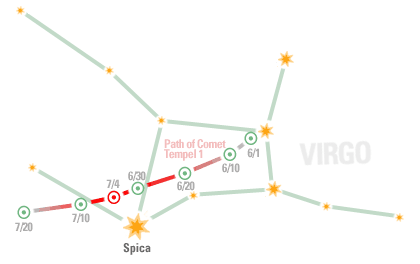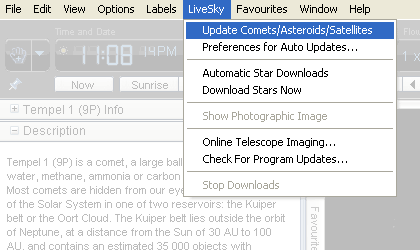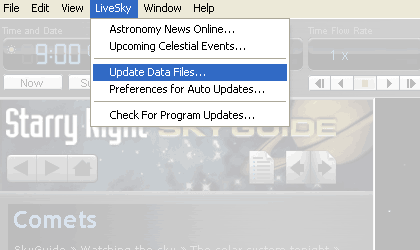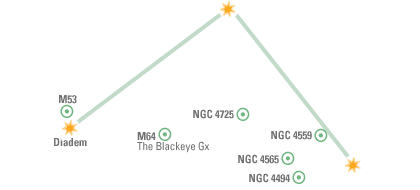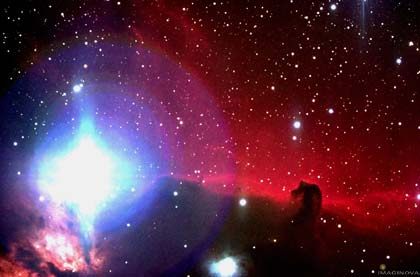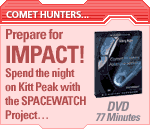 |
||||||||||||||||||||||||||||||||||||||||||||||||||||||||
|
If you have trouble viewing this newsletter, click here.
WHAT: NASA’s historic Deep Impact mission is set to climax on July 4th with the planned collision of a man-made projectile with a comet called 9P/Tempel 1. The 820-pound, washing-machine-sized “impactor” launched from the Deep Impact spacecraft will smash into the comet’s nucleus at 23,000 miles per hour, expelling ice and dust debris and gouging out a crater a couple of football fields wide and some 50 yards deep. WHEN: Impact will occur around 0600 hours Universal Time July 4th, which is 11 PM Pacific Daylight Time on July 3rd. WHO: Observers in the westernmost region of North America will be favorably positioned to view the impact, and sky-watchers around the world should have a good view shortly thereafter. WHERE: Look for the comet low in the southwestern sky in the constellation Virgo. The comet will be faintly visible with just about any telescope or full-sized binocular.
WHY: By analyzing the blown-out debris and the freshly excavated crater itself, scientists expect to learn more about what comets are made of. And from that they hope to gain new insights into how the solar system was formed. HOW: To get a good look at Comet Tempel 1, a telescope is the way to go. Any telescope design will do—refractor, reflector, or Cassegrain, but the bigger its optics, the more vivid the image will be. From a dark-sky site, a telescope with 4” optics should begin to reveal the comet’s hazy glow. (if you have a smaller telescope, go ahead and give it a try. You just might get lucky.) You’ll have better luck with an 8” or larger telescope, which will be a reflector or Schmidt-Cassegrain. Remember that moonlight will wash out the comet from June 8 to 23, so plan on starting your observations on the 24th, if you haven’t already, when the Moon comes up later in the evening. To get the telescope pointed in the right direction, locate Spica in the finder scope and use your telescope’s slow-motion controls to center it on the finder’s crosshairs. Remember that the view in a typical finder scope will be upside-down compared to a normal view. If you’re using a star chart, rotate it 180 degrees to match the view in the finder scope. It’s also important to know how the image in the main telescope’s eyepiece compares to the star chart. In a reflector telescope the image will be upside-down. In a refractor or Cassegrain used with a “star diagonal” in front of the eyepiece, the view will be mirror-reversed, so you will have to mentally flip it back or else turn your star chart over and read it from behind to match the eyepiece view! From Spica, move the telescope a few degrees in the direction of the comet using the mount’s slow-motion controls. Refer to the detailed star chart to determine where the comet should be relative to Spica. With a low-power eyepiece in the telescope’s focuser, see if you can identify the comet’s fuzzy glow. If you can’t, sweep the area a little with the slow-motion controls until you find it. Once you have Tempel 1 in the eyepiece’s field of view, study its appearance for a while. Can you detect any shape to its diffuse tail? Now insert a higher-power eyepiece, one that provides 100x magnification or so. The view will be dimmer but you may resolve more structure. Try other magnifications using other eyepieces, too, if you have them. Of course, after the impactor slams into the comet on July 3/4, it should become much easier to see. Will the blown-off debris cloud cause the comet to look any bigger, or just brighter? How soon after impact will its appearance start to change? And how long will the “extreme makeover” persist? Nobody has the answers to these questions right now. But with a good telescope, a good eye, and patient observation, you can have fun finding out! MORE: Our Comet Catcher Guide to Tempel 1 PDF has everything you'll need to find and observe the comet. And check our complete Deep Impact Special Report for the latest information as the hours click by. Steve Peters
It's easy to find Comet Tempel 1 in Starry Night. Simply type "Tempel 1" in the Find pane to locate where in the night sky the comet is. BONUS for Registered Users of Version 5.0: Receive exclusive information and images about Deep Impact delivered directly into Weekly Sky Events of the SkyGuide. Here's how... If you are a registered user of Starry Night Enthusiast, Pro or Pro Plus, simply go to the LiveSky Menu and click on "Update Comets/Asteroids/Satellites" to get the update. It will appear in the Weekly Sky Events section of the SkyGuide.
If you are a registered user of Starry Night Complete Space & Astronomy Pack, simply go to the LiveSky Menu and click on "Update Data Files" to get the update. It will appear in the Weekly Sky Events section of the SkyGuide.
Register your Starry Night version 5.0 to receive this and other breaking news updates.
Berenice was an Egyptian queen, the wife of King Ptolemy III Euergestes. When her husband went off to war, she promised her hair to Aphrodite to ensure his safe return. The King did return and Berenice had to give up her hair. Diadem is a binary star about 47 lightyears from us. It's two suns cannot be split in telescopes but, just a little to the north, M53 hangs in space at a much greater distance: 60,000 lightyears. M53 is a halo cluster, filled with dozens of Mag 13 stars. M64, The Blackeye Galaxy, gets its famous name from the dark dust lane that cuts through the galaxy's core. With averted vision, you'll just be able to make out the lane. Overall, the galaxy is bright enough to be visible in binoculars. NGC 4725 is a large bright spiral galaxy which has been warped by its interactions with close-by NGC 4747. This patch of sky also contains the North Galactic Pole. NGC 4559, a faint spiral galaxy, is inclined 20° from edge-on. The larger your scope the better the view. NGC 4565 is inclined only 4° from edge-on and is breath-taking. Both galaxies belong to the Virgo Cluster. NGC 4494 is an elliptical galaxy whose core rotates very rapidly—and in the opposite direction to the stars in the outer disk! Sean O'Dwyer, Starry Night Times Editor
Calling All Photographers! As the Comet Tempel 1 is expected to brighten noticeably after impact, Starry Night encourages photographers from across the world to submit their best "before" and "after" pictures of the comet to SPACE.com's newly launched AMAZING IMAGES gallery of the best user-submitted earth and space imagery. https://www.space.com/amazingimages/ Here's one of the amazing images already posted to the gallery:
Horsehead Nebula. Submitted by ksablin; taken with AstroPhysics 130mm f/8.35. Vote for the best photo, and register to join the AMAZING IMAGES community to share your opinions on photography, astronomy and more. Stay tuned for details of the upcoming AMAZING IMAGES contest to choose the best Comet Tempel 1 image. Coming soon! Amazing Images will be automatically linked to Starry Night LiveSky pane. Submit your photo, and it may appear in future LiveSky updates.
|
June 2005
|
|||||||||||||||||||||||||||||||||||||||||||||||||||||||
 |
||||||||||||||||||||||||||||||||||||||||||||||||||||||||
|
|
||||||||||||||||||||||||||||||||||||||||||||||||||||||||
